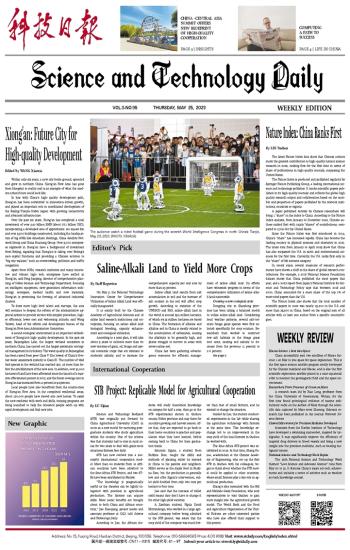
 China-Central Asia Summit Offers New Blueprint of High-quality Cooperation
China-Central Asia Summit Offers New Blueprint of High-quality Cooperation Computing a Path to Success
Computing a Path to Success Xiong'an: Future City for High-quality Development
Xiong'an: Future City for High-quality Development Nature Index: China Ranks First
Nature Index: China Ranks First Saline-Alkali Land to Yield More Crops
Saline-Alkali Land to Yield More Crops WEEKLY REVIEW
WEEKLY REVIEW STB Project: Replicable Model for Agricultural Cooperation
STB Project: Replicable Model for Agricultural Cooperation New Graphic
New Graphic WECHAT&E-PAPER
WECHAT&E-PAPER PHOTO NEWS
PHOTO NEWS
On May 5, the National Technology Innovation Center for Comprehensive Utilization of Saline Alkali Land was officially inaugurated.
It is jointly built by the Chinese Academy of Agricultural Sciences and 18 saline land research institutions and enterprises, focusing on saline-alkali land biological breeding, capacity enhancement and ecological utilization.
According to a joint plan, it will take about 3 years to cultivate more than 80 new varieties of grain, oil, forage and special economic crops that are resistant to moderate salinity, and to increase the comprehensive capacity per unit area by more than 25 percent.
Saline-alkali land results from salt accumulation in soil and the increase of salt content in the soil will affect crop growth. According to statistics of the UNESCO and FAO, saline-alkali land in the world is around 954 million hectares, of which 99.13 million hectares are based in China. The formation of alkaline and alkaline soil in China is mostly related to the accumulation of carbonates, causing the alkalinity to be generally high, and plants struggle to survive in areas with severe saline soil.
China has been gathering advantageous resources for efficient management of saline-alkali land. Its efforts have witnessed progress in terms of the comprehensive utilization of saline-alkali land nationwide.
Creating a new ecological cycle
Dongying city in Shandong province has been taking a balanced model to utilize saline-alkali land. Considering local weather patterns, several salt-tolerant forage grass species were first selected specifically for crop rotation. Researchers then worked to construct low-salt habitats in the forage grass root zone, causing soil salinity to decrease from the previous 11 percent to 2.6 percent.
The planted forage grass, such as sugar sorghum and triticale, are combined with local advantageous forage species like reeds and wild soybeans to form balanced nutrition formula for sheep breeding. Researchers also used livestock and poultry breeding manure, adopting highly efficient aerobic anaerobic dual-use microbial fermentation strains and automated fermentation devices to promote adequate compost fermentation, and achieved 100 percent utilization rate of agricultural organic waste.
Returning bio-organic fertilizer to the field can promote the formation of soil agglomerates, while adding forage planting can quickly improve the basic arable strength of saline-alkali land. Using this model, in the course of planting grass for sheep, farmers can fertilize grass with sheep manure and eventually maximize the utilization rate of ecological cycle model.
Bringing economic and environment balance
Since 2012, Daan city in Jilin province has been ameliorating saline-alkali land by planting rice.
"In nine out of 10 years this area is in drought. Evaporation is almost four times the amount of rainfall, causing accumulative effects of salts within the soil to surface," said Li Jinyou, a staff member at the Natural Resources Bureau of Daan city, adding that another serious issue is that no control system is placed to prevent accumulated salt on the soil surface from spreading to other places and then causing wide salinization.
Researchers first levelled the uneven saline land, covered it with sandy soil and then started rototilling. They added soil amendments, washed the whole field with water and then planted rice to cure alkali.
Once these unused saline alkali lands are transformed into arable land, it can be traded on a balance-of-occupancy land trading platform, backed by a national land and resources management system. These arable lands can then be sold through platforms to increase the region's budget, and the trading price is generally the sum of decades of income from the occupied land or surrounding arable land when it is fully planted.

 Next
Next



